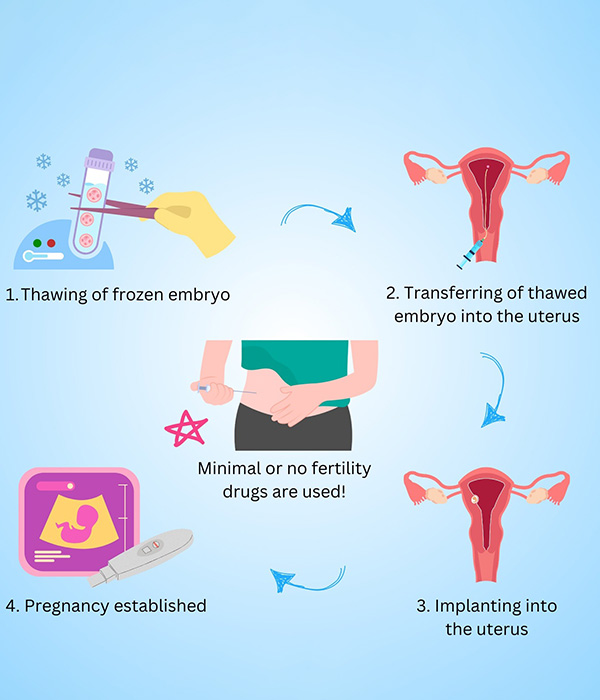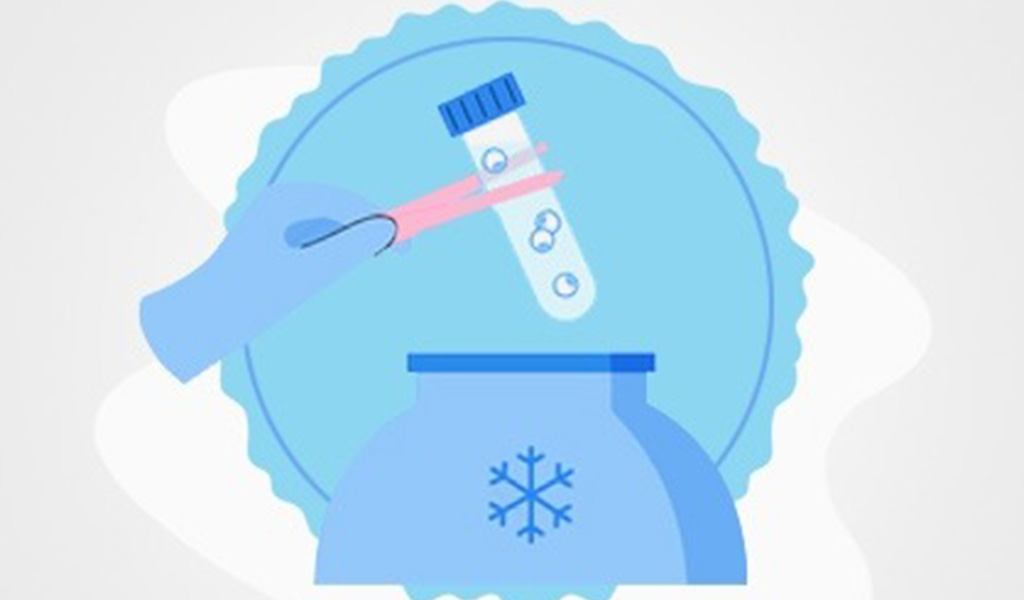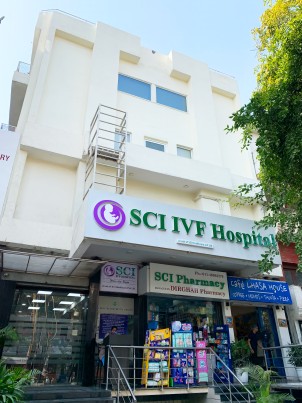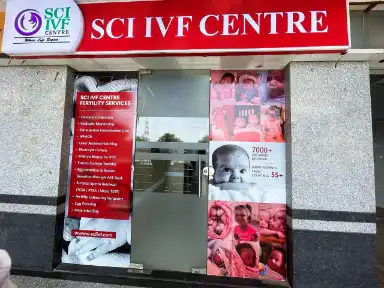Frozen Embryo Transfer Treatment in Noida
Book an AppointmentWhat is Frozen Embryo Transfer Treatment?
Frozen Embryo Transfer (FET) uses embryos that were frozen during earlier IVF cycles. You skipped the full egg stimulation again. Instead, your uterine lining is prepared—either naturally or with mild hormones. At the right time, a frozen embryo is thawed and placed into the uterus. The process is quick, and you go home soon after. SCI IVF handles FET in a calm, simple way. Many couples use it as a second chance without starting IVF over. It often works just as well as fresh embryo transfers. It minimizes medication and stress.
Book An Appointment
Important Lab Tests Before Treatment
For Men
- Check estrogen, progesterone, and sometimes thyroid levels to time the lining.
- Ultrasound to measure endometrial thickness and detect fibroids or polyps.
- Blood tests include infection screens like HIV, HBV, and HCV.
- Examine sugar levels to rule out diabetes.
For men (if partner provides fresh sample)
- Semen analysis if using fresh sperm.
- Blood tests (like karyotype) if there’s an infertility history.
- Consent forms and health history review are required before thawing any embryos.
What to Expect?
During the Process
- Hormones or natural cycle are used to prep the lining.
- You come in for an ultrasound and blood checks.
- On transfer day, embryo thawing happens in the lab.
- A fine catheter is used for placement—it takes just minutes.
- You may rest briefly, then go home.
- No anesthesia needed.
- The total visit lasts a few hours.
- After transfer, no strenuous activity.
After the Process
- Light cramps or spotting may happen.
- Most women resume regular routine in a day.
- Avoid lifting heavy things for a few days.
- Keep taking hormonal support as prescribed.
- A blood test is done after about 10–14 days.
- The uterus may feel tender; it’s normal.
- Emotional support is available.
- Report fever or heavy bleeding promptly.
Success Rate of Frozen Embryo Transfer Treatment in Noida
Results depend on age, embryo quality, and lining. At SCI IVF, success rates range between 45–and 55% per FET cycle. Younger women may see higher rates. Frozen embryos survive well now, so outcomes match fresh transfers. Many couples see live birth rates similar to regular IVF. Solid lab technique and timing help deliver results.
Cost of Frozen Embryo Transfer Treatment in Noida
The cost of IVF with frozen embryos in Noida at SCI IVF is ₹25,000–₹40,000. This covers monitoring, embryo thawing, and transfer. Hormones, scans, and blood tests are extra. Clear pricing is provided upfront. No hidden expenses.
Step-by-Step Procedure
- Consultation & Planning – Doctor reviews previous IVF cycle and confirms embryo quality.
- Cycle Prep – You either follow your natural cycle or take mild estrogen/progesterone.
- Monitoring – Ultrasound and hormone tests check the uterine lining until ready.
- Embryo Thawing – In the lab, embryos are warmed slowly. Survivors are evaluated.
- Embryo Transfer – A soft catheter places the embryo into the uterus. It’s quick and gentle.
- Rest Time – You rest for 20–30 minutes, then go home.
- Hormone Support – Progesterone or estrogen is continued for two weeks.
- Pregnancy Test – After about 10–14 days, a blood test confirms pregnancy.
- Follow-Up Scan – Around 6–7 weeks, an ultrasound checks the heartbeat.
- Ongoing Care – Hormones continue until around 10–12 weeks if pregnancy is confirmed.

Benefits of Frozen Embryo Transfer Treatment
- Uses embryos you’ve already created
- Cuts down on new egg retrieval cycles
- Less medication, less stress
- Embryos frozen at the peak stage for better survival
- Success rates match fresh transfers
- Good option after a failed fresh IVF attempt
- Flexible timing—you decide the schedule
- Lower risk of ovarian hyperstimulation
- Cost-effective for future pregnancies
- Safe and well-tolerated by most women
What is the Age Limit for Frozen Embryo Transfer Treatment?
FET is best under 40 years for optimal results. Women up to 45 can still try, though success lowers after 40–42. Both partners’ health and history guide the decision. Together with your doctor, you’ll pick the best plan for your situation.
Why Do People Choose Frozen Embryo Transfer?
Couples pick FET to avoid going through full IVF again. Frozen embryos are handy, and it’s less intense. Many want a second baby with the same embryo set. It’s also used if the fresh cycle was delayed due to health or COVID-like situations. It lets doctors match the embryo and the lining perfectly. And that matters for success.
What Do You Do to Prepare for Frozen Embryo Transfer?
- Discuss your last IVF cycle and embryo history
- Get hormone levels and infection tests done
- Avoid alcohol, smoking, and heavy caffeine
- Eat well and drink enough water
- Light exercise, no extreme workouts
- Follow the hormone instructions carefully
- Track your cycle with clinic forms
- Do vaginal ultrasounds as scheduled
- Inform the doctor about the meds or supplements you use
- Arrange for someone to drop you home post-transfer
- Wear loose clothes and comfy shoes
- Keep a calm routine—sleep, eat on time
- Ask all your questions ahead of time
- Bring a support person if it helps you stay calm
- Have a heating pad ready for mild cramps
- Watch the embryo tracking app if provided
What Are the Results After the Procedure?
- You’ll feel mild cramps or tenderness
- Light spotting may happen
- Continue progesterone or estrogen
- Avoid heavy exercise or sex for a few days
- Wait 10–14 days for the blood test
- Results come via phone or a clinic visit
- Positive test leads to a scan at 6–7 weeks
- A negative result means planning the next steps
- Emotional swing is normal—support is key
- Discuss the ongoing plan with the doctor
Why Choose SCI IVF For Frozen Embryo Transfer Treatment Noida?
- Skilled team in FET cycles
- The lab keeps embryos in stable, controlled settings
- Soft catheters, gentle transfer methods
- Many couples return here for a second FET cycle
- Honest talk about success rates and costs
- Clear scheduling and reminders
- Trusted Fertility Cycle Clinic Noida for frozen embryo work
- Comfortable clinic with patient-first care

FAQs on Frozen Embryo Transfer Treatment
Yes, frozen embryos can remain viable for many years if stored properly using vitrification. Many successful pregnancies have occurred from embryos frozen for over a decade. As long as freezing and thawing are done carefully, long-term storage doesn't reduce their quality or chance of resulting in a healthy live birth.
No, stopping work after a frozen embryo transfer isn’t usually necessary. Most women return to daily activities the next day. However, it’s advised to avoid strenuous physical work, stress, or heavy lifting. Light rest, a calm environment, and healthy habits are enough for a safe and smooth recovery post-transfer.
FET skips the egg stimulation and retrieval step. Embryos are already frozen, so the focus is only on preparing the uterus. You avoid hormone injections, making the process easier. It's simpler, less invasive, and can be timed better, especially if your body needs a break after a fresh cycle.
The first pregnancy scan is done 6 to 7 weeks after embryo transfer. This scan checks for the gestational sac and heartbeat. It’s usually done transvaginally for clearer imaging. If the embryo implants well, a heartbeat should be seen. It confirms a progressing pregnancy and reassures both the doctor and the couple.
Yes, FET is commonly done after a failed fresh IVF cycle. Many couples have better outcomes with frozen transfers. It allows the body to recover and the uterus to be better prepared. With modern technology, FET success rates are comparable, sometimes higher, especially if embryo quality and timing are right.



